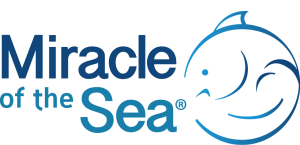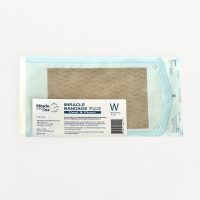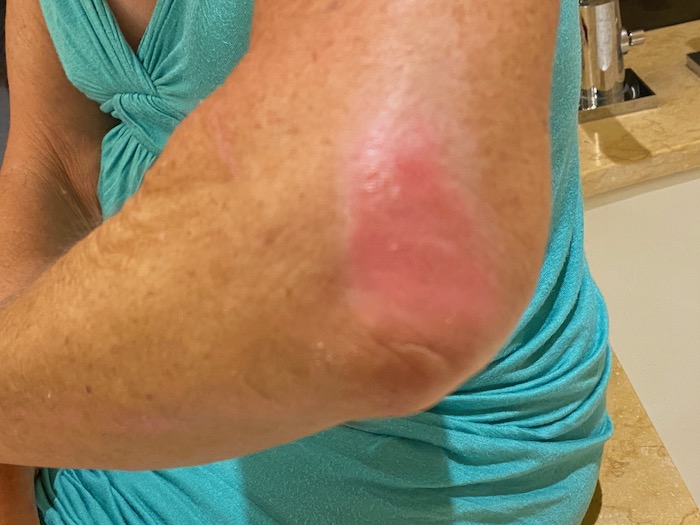Superficial Wound Care at Home
Wound Care Challenges
How often does your elderly loved one develop an injury, such as a skin tear or bruise only to have it expand as she or he attempts to treat it? To have them attempt to change the present-day bandages at least every day is foolhardy. The frequent changes are not only difficult to do but also strips the healing wound and irritates, and may disrupt the surrounding skin. This not only prolongs the healing of the wound, but usually makes the wound worse.
What if there was a bandage that could be placed on anyone and left in place until the wound was healed, decrease the chance of infection, improve the speed of healing the wound and improve the quality of the surrounding skin. This bandage could be cleaned, monitored and able to apply medicinals without changing the bandage. This bandage is here, and it is called Miracle Bandage Plus. It not only protects the wound and its surrounding skin, but with the natural marine extract crystals incorporated into the bandage, it delivers compounds, the ingredients of which not only speed up the healing of the wound, but also improve the health of the surrounding skin.
This dressing also eliminates the stress of your loved one trying to change the bandage on a daily basis
Please find following details on the challenges of burns, abrasions, skin tears and bruises.
Burns and Abrasions
Second-degree burns and skin abrasions are partial damage into - but not completely through - the dermis (skin).
These second degree burns and skin abrasions are among the most painful injuries not only at the time of the injury, but each and every day when the wound dressings are changed. Daily wound changes are necessary because these injuries create exudate and blood which, if left in place, dramatically increase the chance of infection. Not only are these dressing changes painful, they are also disruptive, removing much - and sometimes all - of the healing portion of the wound. These dressing changes also damage the surrounding skin by adhesive tape irritation, which markedly slows the healing process, increases the chance of infection and exaggerates the scarring process.
Skin Tears in Thin Fragile Skin
Skin Tears are acute traumatic injuries involving the separation (flap) of the epidermis from the deeper portions of the skin. These most commonly occur in elderly people who have thin, fragile skin. The skin tears usually result from shear force applied to the skin from friction or trauma. Often, these - sometimes very large - wounds turn into poorly healing, frequently infected wounds. The adhesive dressings currently used on skin tears in the elderly typically cause disruption of the wound with inflammation, bleeding, irritation and skin breakdown of the surrounding skin.
The International Skin Tear Advisory Panel (ISTAP) classifies skin tears into three types: 1) no skin loss with the flap being able to be repositioned; 2) partial skin loss; or 3) total skin loss. The degree of skin loss is directly proportional to the required healing time and the probability of complications, including infection and recurrent injury. A major factor is the weakening of the links between the upper and lower layers of the dermis. These weak links are related to skin age, which is commonly greater than one's chronological age. Conditions such as easy bruising, diabetes, liver disease, kidney disease, significantly poor nutrition, and some medications (such as steroids, immuno-suppressives, anti-inflammatories, and anticoagulants) dramatically increase the probability of skin tears.
Treatment Strategies for Skin Tears
The best treatment strategy includes preserving the viability of the flap and protecting the surrounding skin from adhesive irritation. Limiting dressing changes to both the wound and surrounding skin - with longer dressing intervals - is also important. The ability to monitor for signs of infection, and the ability to clean blood and exudate from the wound as needed (up to 2-3 times a day) should be accomplished without disturbing the flap.
The Causes of Bruising in Older Adults
One of the most hated signs of “getting old” is developing patches of bruising (purpura or ecchymoses) especially over the forearms, hands and legs. Most commonly, these are due to a genetic predisposition of elderly people with thin, atrophic skin. Other contributing factors include anticoagulants / blood thinners (to prevent clot formation), IV placements, platelet disorders, coagulation disorders, and vascular disorders. On very rare occasions, bruises are found with typhus, meningococcus, and bacterial infections. Thin, atrophic skin is very vulnerable to even the slightest of traumas which can result in extensive bruising.
Bruising (purpura/ecchymoses) are wounds created by blood separating the upper (papillary) dermis from the deeper (reticular) dermis. This is a vulnerable area because the natural connection between these two layers is weakened by aging and sun damage. Thus, minimal trauma can produce a cleavage of this space and a lake of blood that has few restraining forces to stop its spread - with a tendency to expand spontaneously. Once this bruising occurs, the healing process typically takes 8-12 months to heal (as with all healing wounds). Of course, this takes longer in older individuals. Yet even during this extensive healing period, minimal - or even no - trauma can create another bruise in the exact same place.
Commercial Products Have Been Developed to Cover Up Bruising
Repeated bruising in the same area of skin usually creates one or two types of pigmentation deposition: hemosiderin and melanin. The hemosiderin is the iron from red blood cells and the melanin is from the post-inflammatory hyperpigmentation of melanin cells in the skin. These pigment compounds can “stain” this area of skin for years, as well as increase the weakness of the connections between the upper and lower dermal layers making bruising even easier. It also produces these dark “permanent” blotches which people hate almost as much as the bruising itself. This is so embarrassing and common that many commercial cosmetic products have been developed with the sole purpose of simply COVERING UP THE BRUISING!
The Best Home Care Solution for Skin Tears, Burns, Abrasions, and Cuts is Miracle Bandage Plus
Unfortunately, there had been no bandage meeting those requirements until our introduction of our transformative technology: Miracle Bandage Plus. The extensive research, development, patented inventions, and manufacture of these technologies has produced a dressing with all of the above characteristics.
Miracle Bandage Plus is a 21 day, stay-in-place bandage which can be cleaned and allow medications to be added if desired without changing the bandage. This allows the wound to heal without disruption while the surrounding skin remains trauma-free.
Once or twice a day the wound should be rinsed with water and blotted dry. This speeds the delivery of the embedded ingredients of Natural Marine Extract time-release crystals to promote the quality of healing and improve the resilience of the healed skin. Miracle Bandage Plus falls off on its own - in up to 21 days - which is usually at the point when the wound is healed.
Miracle Bandage Plus is the Solution to Prevent and Help Heal Bruising
The long-lasting Miracle Bandage Plus (MBP) helps heal, protect and make the healed skin more resilient, while stabilizing vulnerable skin to prevent recurring bruising. Patent-pending MBP has two major mechanisms of action. First, Miracle Dressing acts as a barrier (a virtual “second skin”) that stabilizes the skin to minimize bruising. It also minimizes further shear forces and friction that can cause expansion of the existing bruising which limits its ability to heal.
MBP allows the injury/wound to heal without disruption, while stabilizing the entire wound and surrounding skin to minimize shear forces that can easily expand the bruising area. Repeated use of Miracle Bandage Plus has been shown (by biopsy analysis) to increase the collagen (strength), elastin (elasticity) and hyaluronic acid (thickness) of the skin. The ingredients in Natural Marine Extract also promote increases in the number and function of the fibrocytes and capillaries that maintain, build and nourish the skin - changes that are the foundation to making the skin more resilient to further bruising.
-

Miracle Bandage Plus for Superficial Wounds
Price range: $23.97 through $104.85 Select options This product has multiple variants. The options may be chosen on the product page
-

Miracle of the Sea Natural Marine Extract Capsules
Price range: $150.00 through $300.00 Select options This product has multiple variants. The options may be chosen on the product page
Bedsore (Pressure Injury) Prevention
76 year old female with elbow injury
Miracle Bandage Plus (MBP) stayed on for 21 days before falling off on its own when the wound had healed.
When applying, just apply with the joint in a stretched position and MBP will stay-in-place on joints.






